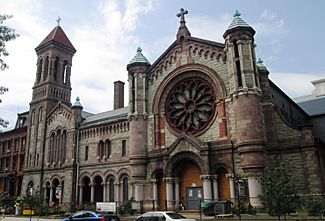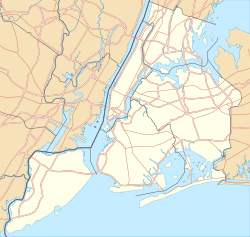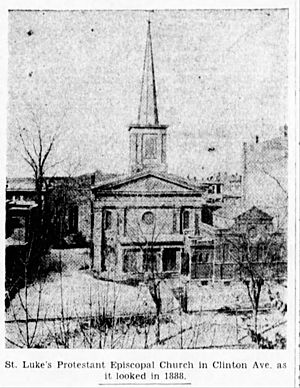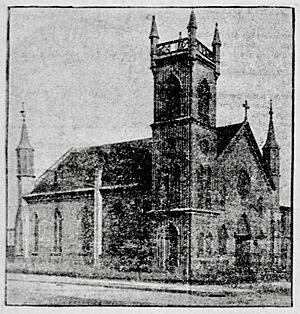Church of St. Luke and St. Matthew (Brooklyn) facts for kids
|
St. Luke's Protestant Episcopal Church
|
|

(2013)
|
|
| Location | 520 Clinton Ave. Brooklyn, New York City |
|---|---|
| Built | 1888–1891 |
| Architect | John Welch |
| Architectural style | Romanesque Revival |
| NRHP reference No. | 82003364 |
Quick facts for kids Significant dates |
|
| Added to NRHP | September 16, 1982 |
The Church of St. Luke and St. Matthew is a historic Episcopal church located in the Clinton Hill neighborhood of Brooklyn, New York City. It stands at 520 Clinton Avenue. The church started as St. Luke's Protestant Episcopal Church in 1842. This happened after an earlier church, Trinity Church, faced financial problems in the same building. The church was built in this area because Brooklyn was growing beyond its original settlements. George W. Pine donated the land, which was made up of eight city lots.
Over time, this church became the largest in the Episcopal Diocese of Long Island. It joined with St. Matthew's Episcopal Church in 1943. Later, in 1993, it merged with the Church of St. Michael and St. Mark.
The Church Building's History
The First Building (1835)
The first building for St. Luke's Protestant Episcopal Church was built in 1835. Elias Combs, a builder, constructed it for Trinity Church. After Trinity Church went bankrupt around 1841, the building was sold. A new group, "St. Luke's Church," bought it for a lower price.
There was a disagreement about whether Mr. Combs had been paid for his work. His widow claimed in 1846 that he had not. Other churches and a local judge supported her claim. St. Luke's Church said the situation was due to Trinity Church's poor management, not a plan to avoid paying. They offered Mrs. Combs a good pew in the church and a deed to her husband's burial vault as payment.
In 1846, someone tried to set the building on fire, but it was stopped quickly. The mayor of Brooklyn offered a $200 reward for information. In 1856, lightning struck the church steeple, damaging wood but not the main structure.
Major repairs happened in 1880. The entrance area was made bigger, and a new front porch was added. The old rectory (the minister's house) was changed into a parish hall. In 1881, a secret donor paid for a new chapel and Sunday school building. This new chapel was dedicated in October 1882.
In 1883, the church bought the house next door at 520 Clinton Avenue. This house became the home for the church's rector (minister).
A big fire in November 1887 damaged the original church. It was caused by a faulty furnace duct. The organ, altar, and the chancel (the area around the altar) were destroyed. However, the main building was still standing and continued to be used for Sunday services.
The Current Building (1888)
The church's current building was constructed between 1888 and 1891. It was designed by John Welch in the Romanesque Revival style. Experts have called it "one of the grandest church buildings in Brooklyn." The building became a New York City Landmark in 1981. It was also added to the National Register of Historic Places in 1982.
After the 1887 fire, a new $6,000 organ was donated and installed in 1889. A new Sunday school building and parish hall were also built. Once these new parts were ready, the old stone church, damaged by the fire, was taken down. A new, larger building was finished in 1891. It could seat 1,500 people. This big project cost a lot, but the church members worked hard to raise money. The mortgage of $33,000 was paid off by 1896. Most of the beautiful stained-glass windows in the main part of the church were installed in 1896. They were made by Tiffany. The round rose window was a gift from the Sunday school children in 1890.
In 1914, another major fire destroyed the inside of this building. Parts of the roof also collapsed. The outer walls remained strong, but the damage was estimated at $300,000.
Rebuilding in 1915
After the March 1914 fire, the church was rebuilt. Workers used the strong outer walls that were still standing. The new design was similar to the old one, but the Sunday school was made larger. The parish hall was also redesigned. The church was under scaffolding for about a year. It reopened on September 19, 1915, and was rededicated on October 19, 1915. The organ was rebuilt in Maryland. It was designed to be the largest in the city at that time.
Fire and Repairs in the 2010s
In December 2012, a fire damaged the building again. Most of the damage was in the entrance area and on the church's front.
In 2017, the church made improvements to its front sidewalk. This was thanks to a grant from the New York City Department of Environmental Protection. They installed a rain garden and special pavement to collect rainwater. In 2018, the church started a project to sell "air rights." This means they allowed a tall residential building to be built nearby. The money from this sale helped pay for repairs to the church's facade and other improvements. This was important to keep the building looking good, as it is a Landmark. The plan for this project was approved in 2019.
Church Activities
Free Church for Everyone
When St. Luke's Church first started, it had financial difficulties. But by 1864, all its debts were paid off. In 1869, St. Luke's became a "free church." This meant that no one had to pay to rent a pew (a church bench). Anyone could attend services for free. St. Luke's was seen as a great example of how a free church system could work well.
Helping Start Other Churches
In 1883, St. Luke's decided to help start another church in Brooklyn. In May 1884, they opened St. Luke's Chapel in a former church building. St. Luke's Church helped build a new building for it in 1886. This new church eventually became its own independent church, known as St. Bartholomew's Church.
Music at the Church
The church had a choir from its early days. In 1865, the women of the church held a fair to raise money for a new organ. By January 1866, a new organ was installed. A concert was held with the choir of Trinity Church, New York, to celebrate it. This organ was one of the largest in the city at the time. It was repaired in 1879. By 1885, the church had three choirs: a church choir, a chapel choir, and a Sunday school choir.
Charles O. Banks became the choirmaster and organist in 1924. He was known for his amazing organ playing. He also organized regular organ concerts at St. Luke's. In 1938, he helped create a Choir Alumni association for former choir members.
St. Luke's and St. Matthew's Join Together
In 1943, St. Luke's Protestant Episcopal Church merged with St. Matthew's Episcopal Church. The combined churches became known as the Church of St. Luke and St. Matthew. They continued to use the St. Luke's building on Clinton Avenue. Charles Banks remained the organist. St. Matthew's Church brought a beautiful stained-glass window of the Apostle Matthew from its old building. This window was placed in the chapel of the current church.
This merger happened because fewer people were attending church. Also, the neighborhoods were changing. Before the merger, St. Matthew's Episcopal Church had faced public discussion. Its former minister had expressed views that caused concern among community leaders. This led to criticism from the bishop and civil rights groups like the National Association for the Advancement of Colored People.
Helping During Hurricane Sandy
In 2012, the Church of St. Luke and St. Matthew building became a main center for Occupy Sandy relief efforts in Brooklyn. Volunteers used the space to gather and sort supplies. These supplies helped people affected by Hurricane Sandy.
In 2015, another nearby church, the Church of the Redeemer, merged with the Church of St. Luke and St. Matthew. This happened after the Church of the Redeemer sold its building.
Church Leaders
Here are some of the people who have served as leaders at the church:
- Rev. Dr. D.V.M. Johnson: 1835–1836
- Dr. Colt
- Dr. Shimeall
- Rev. Dr. J.W. Diller: 1842–1879
- Rev. George R. Van DeWater: 1880–1887
- Rev. Dr. Edward A. Bradley: 1887–1892
- Rev. Dr. Henry C. Swentzel: 1892–1926
- Rev. Rush R. Sloan: 1926 – [1842]
- Rev. John S. Putnam: 1943– ?
- Rev. Harold Courtney: ? –1966
- Rev. William Smith
- Rev. Richard F. Brewer: 1986–2010
- Rev. Michael Sniffen: 2010–2015
- Rev. Christopher Ballard: 2012–2015
- Rev. Julie Hoplamazian: 2017–2018
- Rev. Canon Andrew Durbidge, Priest in Charge: 2019–present
Important Burials
General Gilbert Reid Jr., a Brigadier General, was buried in the family vault of the earlier church building in 1845. In 1853, the church decided to stop burying people in the church vaults. This decision was made for public health reasons.
See also






